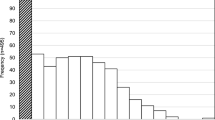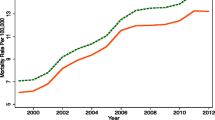Abstract
Introduction
The fatal toxicity index (FTI) is a measure for assessing the relative risks of death due to the medicines prescribed in a population. This knowledge is useful for prescribers and informs medicine safety initiatives. This study aimed to calculate FTIs for the New Zealand population using three methodologies.
Methods
New Zealand coronial data describing medicine-related deaths from 1 January 2008 to 31 December 2013 were retrospectively extracted from the National Coronial Information System. Three fatal toxicity indices were derived using the number of deaths attributed to each pharmaceutical as the numerator and the total defined daily doses, number of patients and number of prescriptions as denominators.
Results
There were 703 medicine-related deaths, of which 627 were assessed as due to one primary contributor. Median decedent age was 48 years (interquartile range 37–58), and 319 (51%) were male. Deaths were intentional in 252 cases (40%), unintentional in 284 (45%) and unknown in 91 (15%). The majority of deaths (n = 486, 78%) occurred in the community. Opioids, antidepressants, antipsychotics and hypnotic-anxiolytics caused most fatalities. While the FTIs for individual medicines varied by denominator applied, methadone and clozapine fatalities were prominent in all three indices. The antidepressants clomipramine, dosulepin and doxepin consistently returned the highest FTIs in their group.
Conclusion
New Zealand prescribers should be aware of the high relative risk of death associated with methadone and clozapine; that clomipramine, dosulepin and doxepin were identified as the most dangerous antidepressants; and that zopiclone carries a similar fatal risk to benzodiazepines. Varying results were found between the FTIs calculated, making comparisons, particularly between populations, difficult.


Similar content being viewed by others
References
Ferner RE. Harms from medicines: inevitable, in error or intentional. Br J Clin Pharmacol. 2014;77(3):403–9.
King LA. Hypnotics and sedatives: an index of fatal toxicity [Letter]. Lancet. 1981;1(8216):387–8.
Cassidy S, Henry J. Fatal toxicity of antidepressant drugs in overdose. BMJ. 1987;295(6605):1021–4.
Barraclough BM. Are there safer hypnotics than barbiturates? Lancet. 1974;303(7846):57–8.
Ojanperä I, Kriikku P, Vuori E. Fatal toxicity index of medicinal drugs based on a comprehensive toxicology database. Int J Legal Med. 2016;130(5):1209–16.
Reith D, Fountain J, Tilyard M. Opioid poisoning deaths in New Zealand (2001–2002). N Z Med J. 2005;118(1209):U1293.
Buckley NA, McManus PR. Fatal toxicity of serotoninergic and other antidepressant drugs: analysis of United Kingdom morality data. BMJ. 2002;325(7376):1332–3.
Girdwood RH. Death after taking medicaments. Br Med J. 1974;1(5906):501–4.
Reith DM, Fountain J, McDowell R, Tilyard M. Comparison of the fatal toxicity index of zopiclone with benzodiazepines. J Toxicol Clin Toxicol. 2003;41(7):975–80.
Cheeta S, Schifano F, Oyefeso A, Webb L, Ghodse AH. Antidepressant-related deaths and antidepressant prescriptions in England and Wales, 1998–2000. Br J Psychiatry. 2004;184:41–7.
Buckley NA, McManus PR. Changes in fatalities due to overdoses of anxiolytic and sedative drugs in the UK (1983–1999). Drug Saf. 2004;27(2):135–41.
Strang J, Hall W, Hickman M, Bird SM. Impact of supervision of methadone consumption on deaths related to methadone overdose (1993–2008): analyses using OD4 index in England and Scotland. BMJ. 2010;341:c4851.
Medicines Amendment Act, New Zealand Statues. 2013. http://www.legislation.govt.nz/act/public/2013/0141/latest/whole.html. Accessed 10 May 2019.
Victorian Department of Justice. National Coronial Information System. https://www.ncis.org.au. Accessed 10 May 2019.
Coroners Act, New Zealand Statues s13. 2006. http://www.legislation.govt.nz/act/public/2006/0038/latest/whole.html. Accessed 10 May 2019.
Fountain JS, Reith DM, Tomlin AM, Smith AJ, Tilyard MW. Deaths by poisoning in New Zealand, 2008–2013. Clin Toxicol. 2019;57(11):1087–94.
WHO Collaborating Centre for Drug Statistics Methodology, Guidelines for ATC classification and DDD assignment 2013. Oslo; 2012.
Stats NZ: Tatauranga Aotearoa. Infoshare. https://www.stats.govt.nz. Accessed 11 Apr 2019.
Medsafe. Suspected Medicine Adverse Reaction Search. https://medsafe.govt.nz/Projects/B1/ADRDisclaimer.asp. Accessed 14 May 2019.
Rose J, Unis AS. A mortality index for postmarketing surveillance of new medications. Am J Emerg Med. 2000;18(2):176–9.
White NC, Litovitz T, Clancy C. Suicidal antidepressant overdoses: a comparative analysis by antidepressant type. J Med Toxicol. 2008;4(4):238–50.
Shipton EE, Shipton AJ, Williman JA, Shipton EA. Deaths from opioid overdosing: implications of Coroners’ inquest reports 2008–2012 an annual rise in opioid prescription rates: a population-based cohort study. Pain Ther. 2017;6(2):203–15.
Saha S, Chant D, McGrath J. A systemic review of mortality in schizophrenia: is the differential in mortality gap worsening over time? Arch Gen Psychiatry. 2007;64(10):1123–31.
Li KJ, Gurrera RJ, Delisi LE. Potentially fatal outcomes associated with clozapine. Schizophr Res. 2018;199:386–9.
Reith D, Fountain J, Tilyard M, McDowell R. Antidepressant poisoning deaths in New Zealand for 2001. N Z Med J. 2003;116(1184):U646.
Medsafe. Medicines: restrictions on the sale, prescribing or administration of medicines under the Medicines Act 1981 and Misuse of Drugs Regulations 1977. 2017. https://medsafe.govt.nz/profs/riss/restrict.asp. Accessed 17 May 2019.
Fountain JS, Sly C, Holt A, MacDonnell S. Availability of antidotes, antivenoms and antitoxins in New Zealand hospital pharmacies. N Z Med J. 2015;128(1411):23–33.
Watts M, Fountain J, Reith DM, Herbison P. Clinical utility of an electronic poisons information and clinical decision support tool. Int J Med Inform. 2003;71(1):3–8.
Fountain JS, Reith DM, Watts M. Comparison of CD-Rom and Internet access to clinical information. Int J Med Inform. 2005;74(9):769–77.
Fountain JS, Reith DH, Holt A. The utilization of poisons information resources in Australasia. Int J Med Inform. 2014;83(2):106–12.
Ferner RE, Easton C, Cox AR. Deaths from medicines: a systematic analysis of coroners’ reports to prevent future deaths. Drug Saf. 2018;41(1):103–10.
Churruca K, Mitchell R. Exploring coronial determination of intent for poisoning-related deaths in Australia, 2001–2013. BMC Public Health. 2017;18(1):83.
Ferner RE. Post-mortem clinical pharmacology. Br J Clin Pharmacol. 2008;66(4):430–43.
Neate SL, Bugeja LC, Jellnek GA, Spooner HM, Ding L, Ranson DL. Non-reporting of reportable deaths to the coroner: when in doubt report. MJA. 2013;199(6):402–5.
Acknowledgements
The authors wish to acknowledge the work of the New Zealand Coronial Service, and thank the National Coronial Information System and the Victorian Department of Justice and Community Safety for providing access to these data.
Author information
Authors and Affiliations
Corresponding author
Ethics declarations
Ethical approval for the study was obtained from the University of Otago Ethics Committee (Reference Number HD16/074) in consultation with the Ngai Tahu Research Consultation Committee. Access to the NCIS was approved by both the NCIS and the New Zealand Chief Coroner.
Funding
No sources of funding were used to assist in the preparation of this study.
Conflict of Interest
John Fountain, Andrew Tomlin, David Reith and Murray Tilyard have no conflicts of interest that are directly relevant to the content of this article.
Rights and permissions
About this article
Cite this article
Fountain, J.S., Tomlin, A.M., Reith, D.M. et al. Fatal Toxicity Indices for Medicine-Related Deaths in New Zealand, 2008–2013. Drug Saf 43, 223–232 (2020). https://doi.org/10.1007/s40264-019-00885-4
Published:
Issue Date:
DOI: https://doi.org/10.1007/s40264-019-00885-4




